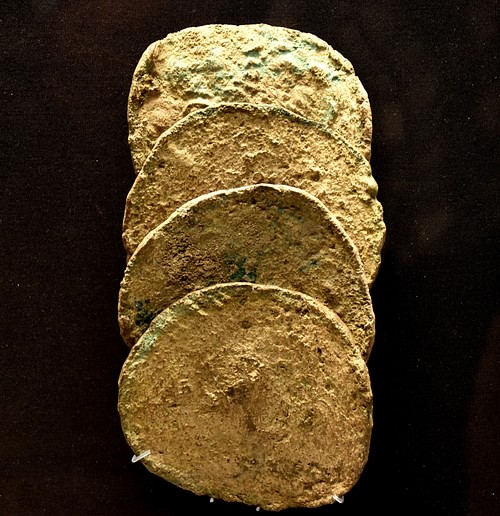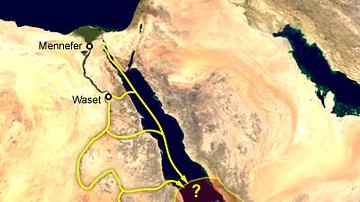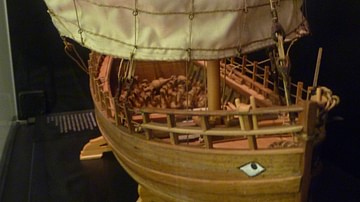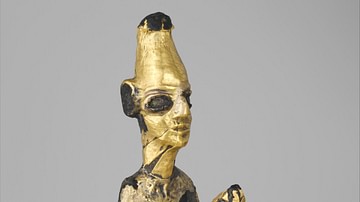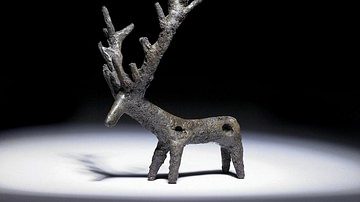Trade has always been a vital aspect of any civilization whether at the local or international level. However many goods one has, whether as an individual, a community, or a country, there will always be something one lacks and will need to purchase through trade with another. Ancient Egypt was a country rich in many natural resources but still was not self-sufficient and so had to rely on trade for necessary goods and luxuries.
Trade began in the Predynastic Period in Egypt (c. 6000 - c. 3150 BCE) and continued through Roman Egypt (30 BCE-646 CE). For most of its history, ancient Egypt's economy operated on a barter system without cash. It was not until the Persian Invasion of 525 BCE that a cash economy was instituted in the country. Prior to this time, trade flourished through an exchange of goods and services based on a standard of value both parties considered fair.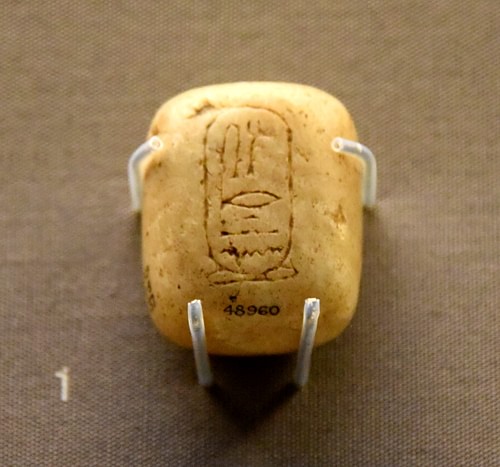
Goods and services were valued on a unit known as a deben. According to historian James C. Thompson, the deben "functioned much as the dollar does in North America today to let customers know the price of things, except that there was no deben coin" (Egyptian Economy, 1). A deben was "approximately 90 grams of copper; very expensive items could also be priced in debens of silver or gold with proportionate changes in value" (ibid). If a scroll of papyrus cost one deben, and a pair of sandals were also worth one deben, the pair of sandals could be traded fairly for the papyrus scroll. In this same way, if three jugs of beer cost a deben and a day's work was worth a deben then one would fairly be paid three jugs of beer for one's daily labor.
From Local to International Trade
Trade began between Upper and Lower Egypt, and between the different districts of those regions, prior to unification c. 3150 BCE. By the time of the First Dynasty of Egypt (c. 3150 - c. 2890 BCE) trade was already long established with Mesopotamia. The First Dynasty kings established a strong central government at their capital of Memphis and a bureaucracy soon developed which handled the details of running the country, including trade with neighboring lands. Mesopotamia was an early trade partner whose influence on the development of Egyptian art, religion, and culture has been noted, contested, and debated by many different scholars over the last century. It seems clear, however, that the earlier Mesopotamian culture - especially the Sumerian - had a significant impact on the developing culture of Egypt.
Early Egyptian art, to cite just one example, is evidence of this influence. Egyptologist Margaret Bunson notes that the famous Narmer Palette from the First Dynasty "with its depiction of monsters and entwined long-necked serpents is distinctively Mesopotamian in design" (267). Bunson also notes that knife handles and cylinder seals from Mesopotamia have been found in Egypt dating to about the same period whose designs were used by later Egyptian artisans.
By the time of the First Dynasty, international trade had been initiated with the regions of the Levant, Libya, and Nubia. Egypt had a trading colony in Canaan, a number in Syria, and even more in Nubia. The Egyptians had already graduated from building papyrus reed boats to ships of wood and these were sent regularly to Lebanon for cedar. The overland trade route through the Wadi Hammamat wound from the Nile to the Red Sea, the goods packed and tied to the backs of donkeys.
While many of these trade agreements were achieved through peaceful negotiation, some were established by military campaign. The third king of the First Dynasty, Djer (c. 3050-3000 BCE) led an army against Nubia, which secured valuable trade centers. Nubia was rich in gold mines and, in fact, gets its name from the Egyptian word for gold, nub. Later kings would continue to keep a strong Egyptian presence on the border to ensure the safety of the resources and trade routes. Khasekhemwy, the last king of the Second Dynasty of Egypt (c. 2890 - c. 2670 BCE), led campaigns to Nubia to put down rebellions and secure trade centers and his methods became the standard for the kings who came after him.
One of the most important trade centers in Nubia is referred to in Egyptian texts as Yam. During the Old Kingdom (c. 2613-2181 BCE) Yam is cited as a resource for wood, ivory, and gold. The precise location of Yam is unknown, but it is thought to have been somewhere in the Shendi Reach area of the Nile in modern-day Sudan.
Yam continued as an important trade center through the Middle Kingdom of Egypt (2040-1782 BCE) but then disappears from the records and is replaced by another called Irem by the time of the New Kingdom (c. 1570 - c. 1069 BCE). The period of the New Kingdom was the time of Egypt's empire when trade was most lucrative and contributed to the wealth necessary to build monuments like the Temple of Karnak, the Colossi of Memnon, and the mortuary temple of Hatshepsut.
Hatshepsut organized the best-known trade expedition to Punt (modern-day Somalia) which brought back boatloads of valuable items, including incense-bearing trees, but this kind of profit from trade was nothing new. The trade initiated during the Old Kingdom of Egypt helped fund the pyramids of Giza and countless other monuments. The difference between Old Kingdom and New Kingdom trade was that the New Kingdom was far more interested in luxury items and, the more they became acquainted with, the more they wanted.
Traded Goods
The kinds of goods traded varied from region to region. Egypt had grain in plenty, and would eventually become known as 'Rome's breadbasket' during the Roman period, but lacked wood, metal, and other precious stones needed for amulets, jewelry, and other ornamentation. Gold was mined by slaves primarily in Nubia and Egypt's neighboring kings often sent letters requesting vast quantities be sent. The journeys to Nubia were not always easy. Yam was located far to the south, and a caravan had to endure threats from bandits, regional rulers, and nature in the form of floods or windstorms.

The best-documented expeditions to Yam come from the tomb of Harkhuf, governor of Elephantine, who made four journeys there under the reign of Pepi II (2278-2184 BCE). On one journey, he reports, he arrived to find the king had gone off to war against another region and had to bring him back, offering him many lavish gifts, in order to secure the items he had been sent for. On Harkhuf's most famous journey he returned with a dancing dwarf, which so excited the young king that he sent word to Harkhuf instructing him to keep the dwarf safe at any cost and hurry him to the palace. The official letter reads, in part:
Come northward to the court immediately; [...] thou shalt bring this dwarf with thee, which thou bringest living, prosperous and healthy from the land of spirits, for the dances of the god, to rejoice and gladden the heart of the king of Upper and Lower Egypt, Neferkare, who lives forever. When he goes down with thee into the vessel, appoint excellent people, who shall be beside him on each side of the vessel; take care lest he fall into the water. When he sleeps at night appoint excellent people, who shall sleep beside him in his tent, inspect ten times a night. My majesty desires to see this dwarf more than the gifts of Sinai and of Punt. If thou arrivest at court this dwarf being with thee alive, prosperous and healthy, my majesty will do for thee a greater thing than that which was done for the treasurer of the god Burded in the time of Isesi, according to the heart's desire of my majesty to see the dwarf. (Lewis, 36)
The dancing dwarf of Pepi II is only one example of Old Kingdom luxury items. Contrary to the claims of some scholars, trade in Egypt did not progress from practicality to luxury but remained fairly consistent regarding the goods imported and exported. The only reason the New Kingdom is always singled out for its luxury is that Egypt was in direct contact with more countries during this period than earlier; it is not because the New Kingdom was suddenly made aware of luxury goods. There is no question, however, that Egyptian trade in the New Kingdom was more efficient and wide-ranging than in earlier eras and that luxury goods became more available and desirable. Bunson describes Egyptian trade during this period, writing:
Caravans moved through the Libyan desert oases and pack trains were sent into the northern Mediterranean domains. It is believed that Egypt conducted trade in this era with Cyprus, Crete, Cilicia, Ionia, the Aegean islands, and perhaps even with mainland Greece. Syria remained a popular destination for trading fleets and caravans, where Syrian products were joined with those coming from the regions of the Persian Gulf. The Egyptians received wood, wines, oils, resins, silver, copper, and cattle in exchange for gold, linens, papyrus paper, leather goods, and grains. (268)
Papyrus shipped to Byblos in the Levant was processed into paper, which was then used by people throughout Mesopotamia and neighboring regions. The association of Byblos with book-making, in fact, provides the basis for the English word 'Bible'. Egyptian trade in the Levant was so widely established that later archaeologists believed there were a number of Egyptian colonies there when, actually, their finds only established how popular Egyptian goods were among the people of the region.
Trade Incentives & Protection
There were no government-sponsored incentives for trade in Egypt because the king owned all the land and whatever it produced; at least, in theory. The king was ordained and sanctified by the gods who had created everything, and served as the mediator between the gods and the people; he, therefore, was recognized as the land's legitimate steward. In reality, however, from the time of the Old Kingdom onward, the priests of the different cults - especially the Cult of Amun - owned large tracts of land which were tax-exempt. Since there was no law prohibiting priests from engaging in trade, and all profit went to the temple instead of the crown, these priests often lived as comfortably as royalty.
For the most part, however, whatever was produced on the farms along the Nile was considered the property of the king and was sent to the capital. Part of this produce was then returned to the people through distribution centers and a part used for trade. Egyptologist Toby Wilkinson writes:
Agricultural produce collected as a government revenue was treated in one of two ways. A certain proportion went directly to state workshops for the manufacture of secondary products - for example, tallow and leather from cattle; pork from pigs; linen from flax; bread, beer, and basketry from grain. Some of these value-added products were then traded and exchanged at a profit, producing further government income; other were redistributed as payment to state employees, thereby funding the court and its projects. The remaining portion of agricultural produce (mostly grain) was put into storage in government granaries, probably located throughout Egypt in important regional centers. Some of the stored grain was used in its raw state to finance court activities, but a significant share was put aside as emergency stock, to be used in the event of a poor harvest to help prevent wide-spread famine. (46)
It was the king's responsibility to care for the people, the land, and maintain the principle of ma'at (harmony). If the land produced abundantly and there was enough food for everyone, as well as surplus, the king was regarded as successful; if not, the priests would intervene to determine what had gone wrong and what steps needed to be taken to regain the good will of the gods.
The Egyptians did not rely solely on supernatural protection in running their country or engaging in foreign trade, however. Armed guards were sent to protect government-sponsored caravans and, during the New Kingdom of Egypt, a police force manned border crossings, collected tolls, protected toll-collectors, and watched over merchants coming and going from cities and villages. Armed escorts which accompanied caravans were a powerful deterrent against theft. Harkhuf reports how, returning from one of his journeys to Yam, he was stopped by a tribal leader who at first seemed intent on taking his goods but, seeing the size of his armed escort, gave him many fine gifts, including bulls, and guided him on his way.
Theft of goods was a serious loss to the organizer of the expedition, the 'businessman' as it were, not to the merchant who actually engaged in trade. If a merchant were robbed, he would appeal to the authorities of the region he was passing through for justice, but he might not always get what he felt was due. A thief had to be identified as a citizen of that region in order for the ruler to be held responsible, and even then, if the thief managed to get away, the king was under no obligation to compensate the merchant.
This sort of situation is described in detail in the literary work The Report of Wenamun (c. 1090-1075 BCE), which relates the story of Wenamun's adventures in leading a trade expedition to purchase lumber for the ship of Amun. Wenamun is robbed by one of his own people in the port and, when he reports the theft to the ruler, he is told there is nothing to be done because the thief is not a citizen. The prince advises Wenamun to stay a few days while they look for the thief but can do no more.
In Wenamun's case, he makes the best of the situation by simply robbing someone else, but usually, a merchant would return to the agency sponsoring the expedition and explain what happened. If the story was accepted, the robbed merchant was held blameless; if the account seemed false, charges would be brought. Either way, the individual or agency whose goods were involved in the trade suffered the loss, not the person who carried them for transaction. One would not, of course, want to acquire a reputation for losing goods, and so for those merchants not employed in government-sponsored trade, which included a detail of soldiers, hiring armed guards was another cost to be considered in pursuing trade.
Whatever the dangers and expenses, however, there was never a time when trade lagged in Egypt, not even during those periods lacking a strong central government. In the so-called intermediate periods, individual governors of districts played the part of the governmental agency and maintained the necessary relationships and routes which allowed for trade. The Report of Wenamun, although fiction, still represents realistically how trading partnerships worked in the ancient world.
A little after the time Wenamun was written, the Greek city of Naucratis was established in Egypt, which would be the most important trade center in the country, and among the most vital in the Mediterranean region until it was overshadowed by Alexandria. Greece, Egypt, and other nations would trade goods as well as cultural beliefs through cities like Naucratis and the overland and sea routes, and in this way, trade enlarged and elevated every nation which participated in ways far more significant than simple economic exchange.
